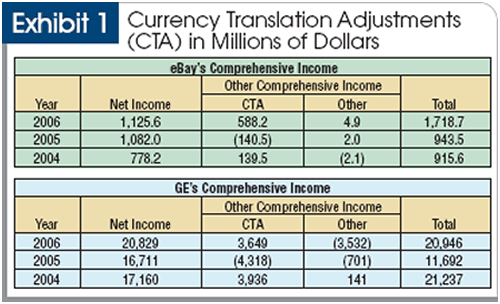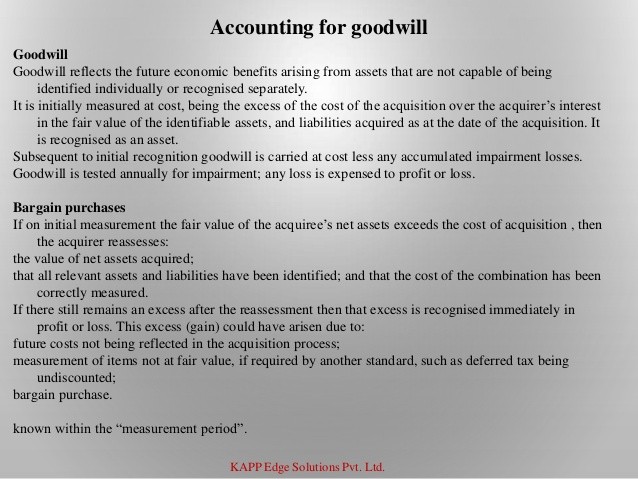The Effect of the New Goodwill Accounting Rules on Financial Statements
Post on: 27 Май, 2015 No Comment

FASB issued SFAS 142, Goodwill and Other Intangible Assets. in June 2001. It made major changes to the accounting treatment of goodwill for the first time in over 30 years. These changes occurred concurrently with the issuance of SFAS 141, Business Combinations. which eliminated the pooling-of-interests method of accounting for business combinations, a method that avoided the goodwill issue entirely. The new accounting rules have had a substantial effect on financial statements, as evidenced by an analysis of the 100 public companies with the largest reported goodwill balances. One-third of these 100 companies wrote off about 30% of their goodwill when they transitioned to SFAS 142. Moreover, elimination of the previous goodwill amortization requirements will likely increase these 100 companies reported annual profits by approximately $20 billion to $25 billion. Changes of this magnitude cause discontinuities in data time series, creating difficulties for users of financial statements in estimating trends and forecasting future performance. And the nominal tax-related cash flow effects associated with these changes demand that more attention be paid to operating cash flow when assessing a companys financial performance.
Prior practice followed APB Opinion 17, issued in 1970, which called for any goodwill recorded following an acquisition to be amortized over a period not to exceed 40 years. Subsequent observation suggested that many companies adopted the 40-year maximum as the useful life in computing amortization to minimize the periodic earnings effect. Even so, and despite that goodwill amortization is a noncash expense that generally provides no tax benefit, in recent years many companies have felt the need to neutralize these effects by reporting supplementary pro forma or cash earnings. This misnomer signals a grossly oversimplified cash earnings that adds back amortization and depreciation to net income.
Because ending amortization while keeping other factors constant will increase earnings and decrease price-to-earnings (P/E) ratios, there was controversy over the potential effect the new rules would have on stock prices. One money manager stated, Low P/E ratios could make stocks look cheaper, even if there hasnt been any change in the companys profit potential (The Wall Street Journal. August 21, 2001). Another observer wrote, And even if an investor doesnt believe the accounting change should boost stock prices, the thinking goes, he or she should act on the belief that others will (The Wall Street Journal. January 21, 2001).
The New Accounting Treatment of Goodwill
SFAS 142 made two major changes to goodwill accounting:
- Amortization of all goodwill ceased, regardless of when it originated. Goodwill is now carried as an asset without reduction for periodic amortization.
- Companies are to assess goodwill for impairment at least annually. If goodwill is impaired, its carrying amount is reduced and an impairment loss is recognized.
Companies were required to implement these new standards in fiscal years beginning after December 15, 2001, with early adoption permitted for fiscal years beginning after March 31, 2001. During the first six months following adoption of SFAS 142, companies assessed existing goodwill balances for impairment and reported any such transitional impairment losses as due to a change in accounting principle. Material impairments of goodwill identified after adoption of SFAS 142 are reported as line items above income from continuing operations. FASB gave companies a reporting benefit during the transition period by allowing them to report real declines in economic value as the effects of changes in accounting principles.
Some companies used the accounting policy note in their SEC filings to help users understand the implications of the change produced by SFAS 142s new rules, or to attempt some spin, as seen in these examples:

- Note 3 in General Electrics first-quarter 2002 10-Q filed with the SEC indicates that previously reported segment profit informationwhich had been charged for goodwill amortizationwas restated to exclude that amortization to be consistent with segment information going forward. In those restated periods GE now treats goodwill amortization as a corporate cost instead of a segment cost. This informs users that they need not revise prior period segment profit numbers by adding back previously deducted goodwill amortization, as GE has already done so.
- Note 2 in Krafts second-quarter 10-Q informs users that During the second quarter of 2002, the Companys reported effective tax rate decreased by 9.2 percentage points compared with the second quarter of 2001 . due primarily to . the Company [being] no longer required to amortize goodwill and indefinite life intangible assets as a charge to earnings. Krafts comment quickly explains the implications of SFAS 142 for a potentially puzzling improvement in this measure of the companys tax burden.
- Note 3 in AOL Time Warners first-quarter 10-Q assures readers that its $54 billion write-off is nonoperational in nature, even though it is clearly disclosed as resulting from a change in accounting principle, perhaps to downplay its impact.
As discussed more thoroughly below, although SFAS 121 provided impairment standards for long-lived assets, these standards did not result in the recording of many goodwill write-offs. SFAS 142 provides a new methodology based on the value of the business related to the goodwill, giving improved guidance to the impairment testing process. An illustration of this process below does not address the complications faced when estimating the required fair values.
Goodwill ImpairmentTesting Process
To test goodwill for impairment, companies must first assign the recorded goodwill to reporting units. These could be the companys operating segments identified under SFAS 131, or a component of a reportable operating segment as defined in paragraph 30 of SFAS 142. In general, companies assign goodwill to each unit by comparing the estimated fair value of the reporting unit as a whole with the fair values of the units identifiable net assets. This process is similar to the process for allocating purchase price differentials among assets acquired, liabilities assumed, and goodwill, in accounting for an acquisition. The sum of these tentative assignments of goodwill to reporting units could exceed the total goodwill recorded by the total entity. When this occurs, the tentative unit assignments are reduced in some reasonable fashion to make the sum equal to the total recorded goodwill. After the goodwill is assigned, at the next impairment testing point the company applies the following two-step process to each reporting unit:
- Step 1: The company estimates the fair value of the reporting unit (UFV) and compares it with the units book value (UBV), which equals the recorded amounts of assets and allocated goodwill less liabilities. When UFV is greater than UBV, there is no impairment, and the test is complete. When UFV is less than UBV, however, goodwill may be impaired, and the company goes to Step 2.
- Step 2: The company estimates the implied fair value (GFV) of the reporting units goodwill by repeating the process performed at acquisition. This requires subtracting estimated current fair values of the units identifiable net assets (INA) from the units estimated fair value (UFV), and comparing the difference with the carrying amount of the goodwill (GBV). When GFV is greater than GBV, goodwill is not impaired and there is no write-off. When GFV is less than GBV, however, the company must record an impairment write-off equal to the difference.
Recognizing Impairment at Transition
Before SFAS 142, companies generally recorded goodwill in total and did not assign it to individual reporting units; that is, they had not completed Step 1. When companies transitioned to the new rules, they assigned their preSFAS 142 goodwill to reporting units using the approach described in Step 2. Impairment losses arose when the total preSFAS 142 goodwill exceeded the sum of the goodwill amounts assigned to the reporting units.
To illustrate the impairment test when transitioning to SFAS 142, consider the following hypothetical information:














